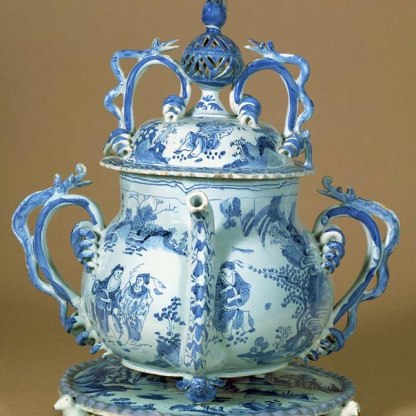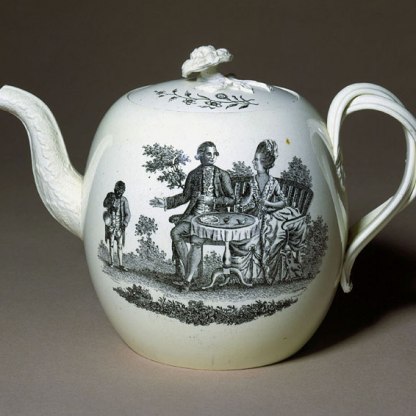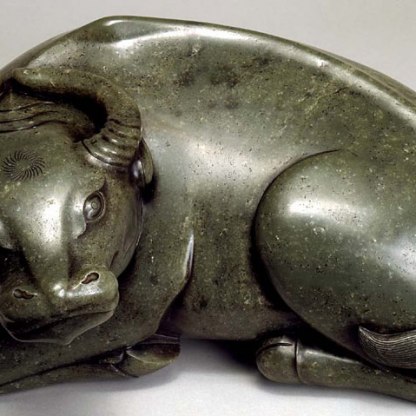Kundika

This elegant, spouted vessel is known as a kundika, or a chongbyong. It is a water sprinkler that was designed for use in Buddhist ceremonies, but by the twelfth century it had come to be used in everyday life for storing liquid. The shape is derived from Chinese metal vessels, but it originated ultimately in India.
The small spout on the body would once have had a hinged lid, and it was through this aperture that the kundika was filled. The water was then poured out from the slender spout at the top.
Buddhism, which had been practised in Korea since the late fourth century CE, was particularly promoted by the Koryo dynasty, the line of rulers founded by Emperor Wang Kon in 918. The Koryo ruled the Korean peninsula for nearly five hundred years until 1392, and it is from that dynasty that the modern name Korea comes.
The five centuries of Koryo rule were a cultural highpoint in the peninsula's history. The Buddhist emperors oversaw the building of huge new temple complexes in the new capital Songdo (modern Kaesong), for which fine ritual objects in lacquer, ceramic and bronze were created. A cast metal moveable printing typeface was developed, years before Johannes Gutenberg printed the first book in Europe in the middle of the fifteenth century. But perhaps the most distinctive and universally admired products of this period are the green or light-turquoise glazed stoneware vessels, known in the West as celadon ware.
Though celadon ware originated in China, the Koryo craftsmen refined it into a distinctly Korean art form. They developed a thinner, more translucent glaze than their Chinese counterparts had used and this allowed for the delicate incised decoration – visible on many of the best examples – to be seen more clearly. Taiping Laoren, a Chinese scholar, described Korean celadon ware as 'first under heaven'.
Beneath the semi-translucent green glaze of the example illustrated here are delicately incised motifs drawn from the natural world, scarcely visible in the photograph. The neck is decorated with lotus petal and cloud motifs, with cranes flying among them on the lower part. The body itself is covered with willow trees on one side and reeds on the other. More lotus flowers are dotted around, and among this foliage are ducks, cranes and geese.
This example was probably made in Sadang-ri in Kangjin district in the south-west of Korea.
Themes and periods
Data from our collections database
Kundika with willow and waterfowl design. Stoneware, thrown, with parts attached, incised and celadon-glazed. This vessel has an ovoid body with a small spout on one side, and a long neck, with a flanged swelling in the centre. The lower part of the body contracts to a splayed footring, giving it a stable shape. The upper part of the long neck is cut into octagonal form, and has incised cloud motifs on each facet, while the projecting ring shows lotus petals and scrolling foliage. The lower part of the neck is decorated with flying cranes among clouds. A classic-scroll border and youi-heads are finely incised round the shoulder, and a key-fret border and further youi-heads round the foot. The body itself shows willow trees on one side and reeds on the other, with ducks and lotuses, flying cranes and geese delicately engraved be-tween. The glaze has a clear, pale blue-green colour with a fine gloss, and evenly covers the entire vessel; a fine crackle covers the whole surface, and near the foot the glaze has in places discoloured. Five quartzite spur-marks are visible on the base, just inside the footring.
Collection of Rev. Stanley T. Smith; sold at Sotheby's, London, 16th October 1951, Lot 28
Legal notes
Given by Mr and Mrs G. St. G.M. Gompertz
Acquisition and important dates
- Method of acquisition: Given
- Dates: 1984
Dating
This type of kundika, which is modelled on bronze examples decorated with silver inlay, was very popular in the Koryo dynasty. Both shape and design are very similar to the metal counterparts. The kundika (Chongbyong) was used in Buddhist ceremonies as a container for water, which was filled in through the spout and sprinkled from the narrow mouth. Similar sherds were excavated at kiln no.7, Sadang-ri, Kangjin-gun, South Cholla province, and were produced in the mature period of Koryo celadon, in the first half of the twelfth century.
Maker(s)
- Probably Unknown Pottery
Note
This type of kundika, which is modelled on bronze examples decorated with silver inlay, was very popular in the Koryo dynasty. Both shape and design are very similar to the metal counterparts. The kundika (Chongbyong) was used in Buddhist ceremonies as a container for water, which was filled in through the spout and sprinkled from the narrow mouth. Similar sherds were excavated at kiln no.7, Sadang-ri, Kangjin-gun, South Cholla province, and were produced in the mature period of Koryo celadon, in the first half of the twelfth century.
Place(s) associated
- Kangjin-gun
Materials used in production
Read more about this recordAudio description
Other highlight objects you might like
Suggested Curating Cambridge products
Sign up to our emails
Be the first to hear about our news, exhibitions, events and more…





